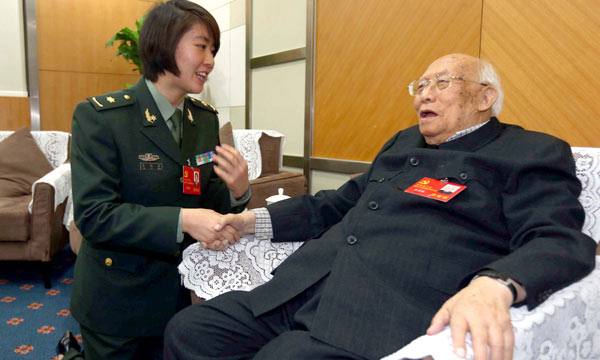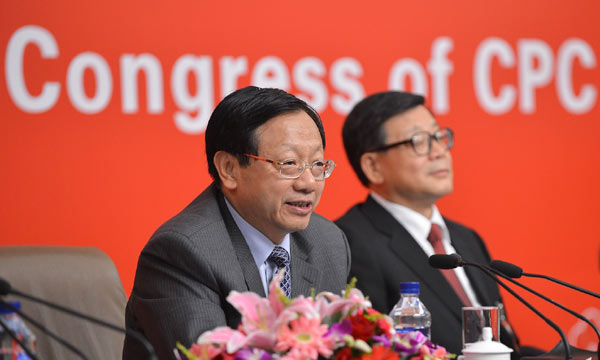Brief History of the Communist Party of China
(china.org.cn)
Updated: 2010-09-07 16:58
Maturing Through Struggles (July 1921-July 1937)

The founding of the Communist Party of China (CPC) in the early 1920s was the objective demand of the development of modern Chinese society and revolution. It was the result of the combination of Marxist theory and the workers' movement in China. The CPC, for the first time in Chinese history, put forward a revolutionary program against imperialism and feudalism, and pointed out the target of struggle for the Chinese people. It adopted the revolutionary method of relying on the broad masses -- a method never tried before by the bourgeois democrats -- which gave impetus to the first upsurge of the workers' movement in China. As a result, the Chinese revolution began to take on a completely new look.



After the founding of the CPC, the Party concentrated its efforts on organizing worker movements. In August 1921, the CPC set up the Secretariat of the Chinese Labor Organization in Shanghai. The secretariat then became the body through which the Party led worker movements. Shown here are the manifesto of the secretariat (left), and Deng Zhongxia, one of the leaders of China’s early-period worker movements (right).
Thanks to the influence of the correct leadership of the CPC and Kuomintang-Communist cooperation, a great revolution against imperialism and feudalism rose around the country. In 1925, the May 30th Movement took place in Shanghai, marking the beginning of a nationwide revolutionary upsurge and laying the foundation for the revolutionary war against the Northern warlords. Known as the Northern Expedition, the war was launched under the slogan -- oppose imperialism and warlords -- raised by the Communist Party. The mainstay of the Northern Expeditionary Army was formed of Communist Party members, members of the Communist Youth League and progressive personages of the Kuomintang (KMT). Along with the victorious advance of the Northern Expedition, the Party-led workers' and peasants' movement grew rapidly, shaking the reactionary rule of the imperialist and feudal forces in China. However, at the critical moment of the struggle, the big bourgeoisie betrayed the revolution, and Chen Duxiu, general secretary of the CPC, pursued an erroneous line of capitulationism. As a result, the revolution failed.
After the failure of the 1927 revolution, the new KMT warlords began their atrocious rule in China. Facing the new situation, the CPC independently held high the banner of revolution by adopting the general principle of agrarian revolution and armed struggle. The Chinese Communists, represented by Mao Zedong, accumulated experience in the struggle and gradually shifted the focus of the Party's work from the cities to the countryside. While in the countryside, the Communist Party mobilized the masses of peasants and established base areas, thus opening up a road of encircling the cities from the rural areas and seizing political power by armed force. Under the leadership of the Party, people in base areas overthrew the landlords and shared out the land. Revolutionary armed forces and workers' and peasants' governments were established. The Communist forces defeated, one after the other, the "encirclement and suppression" campaigns launched by Kuomintang armies. The base areas became scenes of vigorous revolutionary activity.
In 1931, the Japanese imperialists staged the September 18th Incident in an attempt to turn China into its colony. The CPC was the first to hold up the banner of armed resistance against Japan. It called on people of the whole country to fight the Japanese for the salvation of the motherland. As the revolution was resuming its momentum, Wang Ming pursued an erroneous line of "Left" dogmatism, which brought yet another serious loss to the Party. Due to the failure of the struggle against the fifth "encirclement and suppression" campaign, the Red Army was forced to undertake a strategic transfer by going on the Long March.
The Party learned its lessons from the victories and failures of the great revolution and the agrarian revolution. During the Long March, it convened a meeting in Zunyi at which it corrected the "Left" mistakes within the Party and established the leading position of the Marxist line represented by Mao Zedong. The Zunyi Meeting proved to be a critical turning point in the history of the Party. It indicated that the Party had grown out of its infancy. After the meeting, the Party led the Red Army to defeat the enemy's encirclement, pursuing and blocking tactics, and with extraordinary willpower, overcame all sorts of precarious situations. As a result, the Red Army achieved the great victory of the Long March. In the meantime, the Party adopted the new policy of establishing a national united front against Japan. It played an active role in the peaceful settlement of the Xi'an Incident and the realization of a second time of Kuomintang-Communist cooperation, thus paving the way for the nationwide War of Resistance Against Japan.
Video







